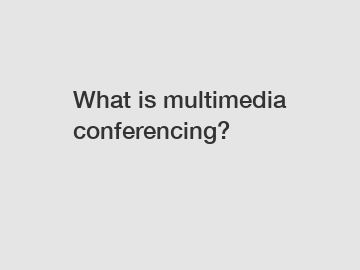What is multimedia conferencing?
What is Multimedia Conferencing?
Are you curious about multimedia conferencing? Wondering what it entails and how it can benefit businesses and individuals? In this article, we will delve into the world of multimedia conferencing and explore its various aspects. Whether you are new to the concept or just want to enhance your understanding, read on to discover more about this innovative technology.
1. What is Multimedia Conferencing?

Multimedia conferencing refers to a collaborative online communication method that enables participants from different locations to connect and interact virtually. It combines various multimedia elements such as audio, video, text, and graphics to facilitate real-time communication. Through multimedia conferencing, individuals can participate in meetings, presentations, and discussions without having to be present physically.
2. Benefits of Multimedia Conferencing.
Multimedia conferencing offers numerous advantages that have revolutionized the way people communicate. One of the major benefits is increased flexibility. With multimedia conferencing, individuals can join meetings or conferences from anywhere, as long as they have an internet connection. This eliminates the need for traveling, saving both time and money.
Additionally, multimedia conferencing promotes collaboration and teamwork. It allows participants to share files, documents, and screens, enabling effective collaboration even when working remotely. This is particularly beneficial for organizations with geographically dispersed teams or clients. Moreover, multimedia conferencing improves productivity by minimizing time spent in transit and providing easy access to resources.
3. Types of Multimedia Conferencing.
There are various types of multimedia conferencing, each catering to different needs and preferences. Video conferencing, perhaps the most well-known, utilizes live video streaming to facilitate face-to-face communication between participants. This type of conferencing is ideal for meetings, interviews, or team discussions where visual cues play a vital role.
Additionally, audio conferencing focuses solely on voice communication. It is a popular choice for conference calls, where participants can engage in discussions without the need for video or other multimedia elements. Audio conferencing is widely used due to its simplicity and ease of use.
Web conferencing takes multimedia conferencing a step further by incorporating additional features such as screen sharing, file sharing, and collaborative whiteboards. It helps in conducting virtual meetings, webinars, or training sessions, allowing participants to actively engage with the content and interact with each other.
4. The Role of Multimedia in Conferencing.
Multimedia plays a crucial role in enhancing the conferencing experience. By combining audio, video, text, and graphics, participants can communicate more effectively and convey their messages clearly. Visual elements such as presentations or charts aid in better understanding and engagement.
Moreover, multimedia enables participants to express themselves beyond words. Facial expressions, hand gestures, and body language can be captured by video conferencing, adding a personal touch to virtual interactions. This helps build rapport and foster a sense of connection even in the absence of physical presence.
5. Challenges and Considerations.
While multimedia conferencing offers numerous benefits, there are also challenges to consider. The most significant challenge is the need for a stable internet connection. Poor connectivity can result in disruptions, delays, or even dropped calls, hindering the smooth flow of communication. It is crucial to have a reliable internet connection to ensure a seamless multimedia conferencing experience.
Another consideration is the potential for technical difficulties. Participants may encounter issues with their cameras, microphones, or software compatibility, leading to frustration and loss of productivity. To mitigate these challenges, it is essential to utilize reliable conferencing platforms, perform regular system checks, and provide technical support when needed.
6. Conclusion.
Multimedia conferencing has transformed the way people communicate and collaborate in the digital age. By leveraging various multimedia elements, businesses and individuals can connect, engage, and achieve common goals regardless of geographic barriers. From increased flexibility to improved collaboration, multimedia conferencing offers a range of benefits that contribute to enhanced productivity and efficiency. Embracing this innovative technology can lead to a more efficient and connected future for organizations and individuals alike. So, what are you waiting for? Dive into the world of multimedia conferencing and experience its transformative power firsthand!
The company is the world’s best audio conference equipment, conference screen, Wireless Simultaneous Interpreting Equipment supplier. We are your one-stop shop for all needs. Our staff are highly-specialized and will help you find the product you need.

Comments
0